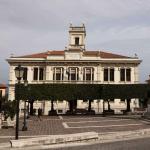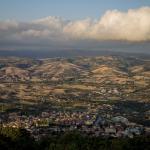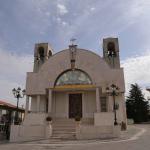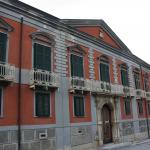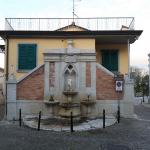The Municipality of Sturno lies in the Ufita Valley area. It's a town with 3,011 inhabitants, located 652 metres above sea level, at 37 km from Avellino. The territory extends for 16.67 sq km and the adjoining municipalities are: Carife, Castel Baronia, Flumeri, Frigento and Rocca San Felice.
The etymology of the name is said to come from an alteration of the word "storno" (starling), in memory of the bird, Sturnus vulgaris. The inhabitants are called Sturnesi and Saint Dominic of Guzman is their patron saint.
PLACES OF INTEREST
- Grella Baronial Palace - Historic 18th century residence, in neoclassical style, belonging to the family of the same name, with a splendid English garden
- Abbey of San Michele Arcangelo (Saint Michael the Archangel) - Rebuilt after the 1980 earthquake is the town's main place of worship
- Church of the SS. Domenico and Francesco (Saints Dominic and Francis) - 18th-century parish church housing numerous wooden works and paintings
- Vicario Palace - First residence of the Grella family was built in the 17th century and rebuilt several times in the following century, before being passed on to the current owners
- de Juliis Palace - Dating back to the end of the 18th century, this palace houses precious interior frescoes
- Chapel of Madonna della Neve (Our Lady of the Snow) - Located at the foot of the woods that surrounds the town to the south has a small square with a beautiful view
- Tetta Fountain - Located in a public park consists of two different structures at a short distance from each other
- "Re la Chiazza" Fountain - La Fontana della Piazza (The Fountain of the Square), built in 1872 in the heart of the town, represents a precious memory of the community
- Bosco Ceduo - Located on the northern slope of Mount Frigento, this woodland is rich in Mediterranean flora
- Cittadella dello Sport - Sturno's sports facilities, including "Il Castagneto", host many football teams during their summer training camps
EVENTS
- Tracciatura del Solco (Ploughing the Furrow) - Rediscovery of an ancient rural tradition that takes place in September, coinciding with the religious festival in honour of Saint Michael
- Feast of Saint Michael - Religious celebrations in honour of the patron saint of the village, held in September
- Feast of Saint Dominic - Religious celebrations in honour of the patron saint, held in August
- Rituals of the Holy Week and Living Via Crucis - Easter event that ends with the evocative representation of the Resurrection
- Agosto Sturnese - Festival rich in musical, theatrical, artistic and sporting events, held in August
TRADITIONAL FOOD AND PRODUCTS
- Irpinia Colline dell'Ufita PDO - Extra virgin olive oil, mostly from the Ravece variety, with a pleasantly bitter and spicy taste
- Ufita garlic PAT - A product with an aromatic taste and a high quantity of essential oils and active ingredients
- Ufita cherry tomato PAT - Of medium-small size, it has a bright red colour and numerous seeds inside
- Menesta maritata - This is a soup where meat and vegetable ingredients are "married" and it is served with pizza jonna (corn pizza)
- Sturnese nougat - Handcrafted for many decades in many delicious varieties
- Caciocavallo irpino di grotta PAT - A spun curd cheese, produced with milk from small and medium-sized farms, mainly from brown cattle, traditionally matured in caves
FUN FACTS
The tradition of ploughing the furrow, once carried out using ploughs pulled by oxen, is now renewed in more modern forms, but which still involve the use of simple tools for the straightforward ploughing of these furrows, which are 5 to 11 km long from neighbouring villages.
During the Holy Week Rituals, the peasant population still brings small clumps of wheat to the altar, kept in the dark and enriched with flowers, as a sign of goodwill for the future harvest.
The inventor of the horn, John Michele Aufiero (1887-1955), was born in Sturno and was an honorary citizen of Avellino.
HISTORICAL NOTES
Some archaeological finds discovered in the territory of Sturno testify to its ancient origin, dating back to the Palaeolithic period. These findings were made specifically in the districts of San Leucio and Serradenzita, and are currently kept in the Irpino Museum in Avellino.
It was with the invasion of the Barbarians and the clashes between the Normans and the Lombards over the occupied areas, however, that some groups of fleeing people began to settle in the territory, forming the Casali (farmhouses), which were part of Frigento. Sturno depended on the latter for a long time, until the Casali gained administrative independence in 1809. There were eight Casali and their names came from the names of the ancient families who lived there; according to a legend, one of them had a tavern where a starling (in local dialect "sturno") was kept in a cage, which gave the unique name of "Casalium Sturni" to all the Casali.
Exploring Sturno, perhaps starting at the table? With the "menesta maritata" you begin to taste the essence of all the authentic flavours of peasant art
Sturno
Piazza Municipio, 1, 83055 Sturno AV, Italia
Featured places
Piazza Michele Aufiero, 6, 83055 Sturno AV, Italia
Rebuilt after the 1980 earthquake, it is the town's main place of worship
Piazza Don Giuseppe Abbondandolo, 83055 Sturno AV, Italia
Eighteenth-century parish church housing numerous remarkable wooden works and paintings
Via Trieste, 5, 83055 Sturno AV, Italia
A historic 18th-century residence, in neoclassical style, belonging to the family of the same…
Did you like it? Leave a review
Your opinion is important! It will be visible after approval by the editorial staff.
To post a comment you must be an authenticated user. Log in with Social Login
